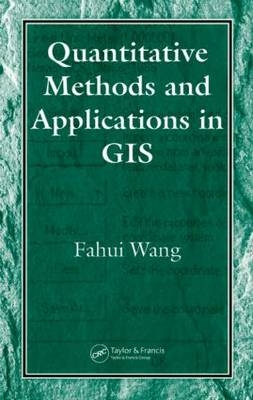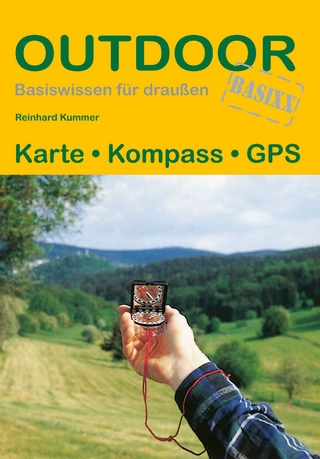
Quantitative Methods and Applications in GIS
Crc Press Inc (Verlag)
978-0-8493-2795-7 (ISBN)
- Titel erscheint in neuer Auflage
- Artikel merken
Quantitative Methods and Applications in GIS integrates GIS, spatial analysis, and quantitative methods to address various issues in socioeconomic studies and public policy. Methods range from basic regression analysis to advanced topics such as linear programming and system of equations. Applications vary from typical themes in urban and regional analysis - trade area analysis, accessibility measures, analysis of regional growth patterns, land use simulation - to issues related to crime and health analyses.
The book covers common tasks such as distance and travel time estimation, spatial smoothing and interpolation, and accessibility measures. It also covers the major issues that are encountered in spatial analysis including modifiable areal unit problems, rate estimate of rare events in small populations, and spatial autocorrelation.
Each chapter has one subject theme, introduces the method (or a group of related methods) most relevant to the theme, and then uses case studies to implement the method in a GIS environment.
Getting Started with ArcGIS: Data Management and Basic
Spatial Analysis Tools
Spatial and Attribute Data Management in ArcGIS
Case Study 1A: Mapping Population Density Pattern in
Cuyahoga County, Ohio
Spatial Analysis Tools in ArcGIS: Queries, Spatial Joins and
Map Overlays
Case Study 1B: Extracting Census Tracts in City of Cleveland
and Analyzing Polygon Adjacency
Summary
Appendix 1. Importing and Exporting ASCII Files in ArcGIS
Measuring Distances and Time
Measures of Distance
Computing Network Distance and Time
Case Study 2: Measuring Distances between Counties and
Major Cities in Northeast China
Summary
Appendix 2. The Valued Graph Approach to the Shortest-Route
Problem
Spatial Smoothing and Spatial Interpolation
Spatial Smoothing
Case Study 3A: Analyzing Tai Place-Names in Southern China
by Spatial Smoothing
Point-Based Spatial Interpolation
Case Study 3B: Surface Modeling and Mapping of Tai Place-
Names in Southern China
Area-Based Spatial Interpolation
Case Study 3C: Aggregating Data from Census Tracts to
Neighborhoods and School Districts in Cleveland, Ohio
Summary
Appendix 3. Empirical Bayes (EB) Estimation for Spatial Smoothing
GIS-Based Trade Area Analysis and Applications in
Business Geography and Regional Planning
Basic Methods for Trade Area Analysis
Gravity Models for Delineating Trade Areas
Case Study 4A: Defining Fan Bases of Chicago Cubs and White
Sox
Case Study 4B: Defining Hinterlands of Major Cities in Northeast
China
Concluding Remarks
Appendix 4. Economic Foundation of the Gravity Model
GIS-Based Measures of Spatial Accessibility and
Application in Examining Healthcare Access
Issues on Accessibility
The Floating Catchment Area Methods
The Gravity-Based Method
Case Study 5: Measuring Spatial Accessibility to Primary Care
Physician in Chicago Region
Discussion and Remarks
Appendix 5. A Property for Accessibility Measures
Function Fittings by Regressions and Application in
Analyzing Urban and Regional Density Patterns
The Density Function Approach to Urban and Regional
Structures
Function Fittings for Monocentric Models
Nonlinear and Weighted Regressions in Function Fittings
Function Fittings for Polycentric Models
Case Study 6: Analyzing Urban Density Patterns in Chicago
Region
Discussion and Summary
Appendix 6A: Deriving Urban Density Functions
Appendix 6B: OLS Regression for a Linear Bivariate Model
Appendix 6C: Sample SAS Program for Monocentric Function
Fittings
Principal Components, Factor, and Cluster Analyses, and
Application in Social Area Analysis
Principal Components and Factor Analysis
Cluster Analysis
Social Area Analysis
Case Study 7: Social Area Analysis in Beijing
Discussion and Summary
Appendix 7A. Discriminant Function Analysis
Appendix 7B. Sample SAS Program for Factor and Cluster
Analyses
Geographic Approaches to Analysis of Rare Events in Small
Population and Application in Examining Homicide
Patterns
The Issue of Analyzing Rare Events in Small Population
The ISD and the Spatial Order Methods
The Scale-Space Clustering Method
Case Study 8: Examining the Relationship between Job Access
and Homicide Patterns in Chicago at Multiple Geographic Levels Based on the Scale-Space Melting Method
Summary
Appendix 8. The Poisson-based Regression Analysis
Spatial Cluster Analysis, Spatial Regression, and
Applications in Toponymical, Cancer, and Homicide Studies
Point-Based Spatial Cluster Analysis
Case Study 9A: Spatial Cluster Analysis of Tai Place Names in
Southern China
Area-Based Spatial Cluster Analysis
Case Study 9B: Spatial Cluster Analysis of Cancer Patterns in
Illinois
Spatial Regression
Case Study 9C: Spatial Regression Analysis of Homicide
Patterns in Chicago
Summary
Appendix 9: Spatial Filtering Methods for Regression Analysis
Linear Programming and Applications in Examining
Wasteful Commuting and Allocating Health Care Providers
Linear Programming (LP) and the Simplex Algorithm
Case Study 10A: Measuring Wasteful Commuting in Columbus,
Ohio
Integer Programming and Location-Allocation Problems
Case Study 10B: Allocating Healthcare Providers in Cuyahoga
County, Ohio
Discussion and Summary
Appendix 10A. Hamilton's Model on Wasteful Commuting
Appendix 10B. SAS Program for the LP Problem of Measuring
Wasteful Commuting
Solving a System of Linear Equations and Application in
Simulating Urban Structure
Solving a System of Linear Equations
The Garin-Lowry Model
Case Study 11: Simulating Population and Service Employment
Distributions in a Hypothetical City
Discussion and Summary
Appendix 11A: The Input-Output Model
Appendix 11B: Solving a System of Nonlinear Equations
Appendix 11C: FORTRAN Program for Solving the Garin-Lowry
Model
| Erscheint lt. Verlag | 3.4.2006 |
|---|---|
| Zusatzinfo | 170 equations; 15 Halftones, black and white; 31 Tables, black and white; 73 Illustrations, black and white |
| Verlagsort | Bosa Roca |
| Sprache | englisch |
| Maße | 156 x 234 mm |
| Gewicht | 590 g |
| Themenwelt | Geisteswissenschaften ► Psychologie |
| Naturwissenschaften ► Geowissenschaften ► Geografie / Kartografie | |
| ISBN-10 | 0-8493-2795-4 / 0849327954 |
| ISBN-13 | 978-0-8493-2795-7 / 9780849327957 |
| Zustand | Neuware |
| Informationen gemäß Produktsicherheitsverordnung (GPSR) | |
| Haben Sie eine Frage zum Produkt? |
aus dem Bereich



